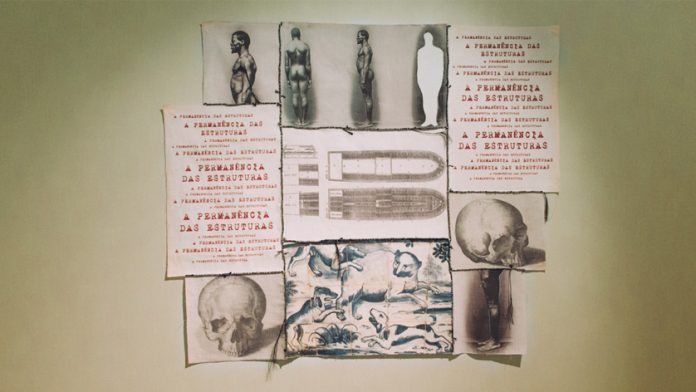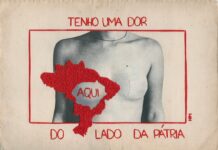In the middle of the artistic production that emerges from the regions of the world’s colonial past, the work of Rosana Paulino has become a reference before our eyes. In the curatorial research that seeks the voices and speeches of this geopolitical pole – and that feeds the actions of Videobrasil -, its force is imposed more and more. I remember the impression I had on the artist’s early works, which I saw, especially the series Bastidores/Backstage (1997), in which an angry and definitive seam takes on the space of decorum and modesty (white, feminine and bourgeois) blind black women. Or the monotypes Proteção extrema contra a dor e o sofrimento/Extreme protection against pain and suffering (2011), in which sewing lines fall from the eyes of a naked woman figure to make up something that looks like a fragile protective coverup, but also a tangle that limits and imprisons.
This last series was chosen by the artist and curator Daniel Lima to integrate the exhibition Agora somos todxs negrxs?, that composed the program at Galpão Videobrasil in 2017. The show also included Tecido Social/Social Fabric, ironic title engraving in which Paulino joins images with sloppy sutures and forced seams to challenge ideas of peaceful sociability and national unity. In order to challenge the perpetuation of the myth of Brazilian racial cordiality, even in the midst of art, Lima brought together a generation that proposes to deconstruct what he describes as the “triple trauma of colonization (extermination of native populations, slavery and religious persecution) of the micropolitical power of art”.
These past experiences with the artist’s work did not prepare me for the impact I felt when I went through the Rosana Paulino’s exhibition: a costura da memória (translated as ‘the sewing of the memory’). It was only in front of the body of work gathered by the São Paulo’s Pinacoteca that I realized the real dimension of the artist’s production. She impresses with the mastery with which she uses a variety of techniques and languages, such as watercolor, drawing, ceramics, video, embroidery, sculpture. But even more so, the poetic and political power of her narrative that plunges into history to bring forth a painful past and its very present inheritance, whether in the form of sensory impact or through instigating associations of ideas.
Looking back over more than two decades of the artist’s production, it is especially noteworthy to realise the delicacy with which she exposes extreme issues and situations, such as violence imposed on women, especially black women, the ill-concealed Brazilian racism, and the absence and social invisibility on black people, often reduced to the condition of object of study to the natural sciences by our historical iconography – a repertoire of which Rosana, not for nothing, is widely used. Some among many examples are the delicate and fluid trait with which she reconnects to the land the black female body, fragmented and uprooted by slavery, in Assentamentos/Settlements; and the lightness of the small ceramic sculptures assembled at the installation Tecelãs/Weavers (2009), which evokes with great poignancy the pain of the dual submission of being a woman and a black woman.
Rising to a mature production of rare power, the exhibition at Pinacoteca reveals Rosana Paulino as one of the most important artists in action in the Brazilian contemporary scene. This perception reinforces, but does not precede, the invitation we made to Paulino to present, at the 21st Biennial of Contemporary Art Sesc_Videobrasil, an unpublished work, which is being commissioned by the event. The Biennial stars in October in São Paulo and investigates, through an expressive set of works, poetics from the South that relate to the idea of new communities, created by principles distinct from those that founded the national states. As those that approach a familiar or tribal character, expressing their affections in domestic or memorialistic experiences. Starting from recurring issues in her work, related to memory and ancestry, Rosana Paulino dialogues with this universe and ventures into a new language. The exhibition presented at Pinacoteca will be at MAR – Rio Art Museum on April 13 and can be visited until the end of August.














